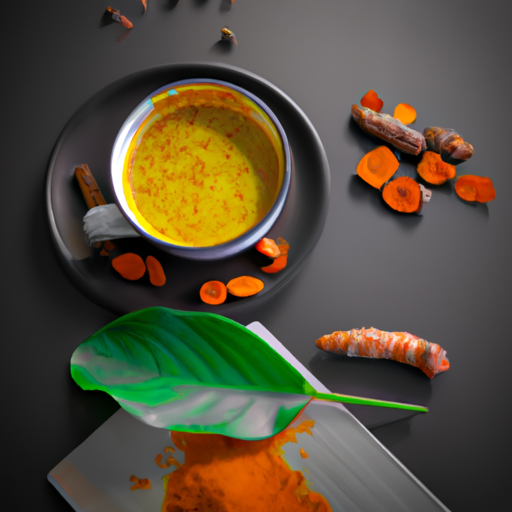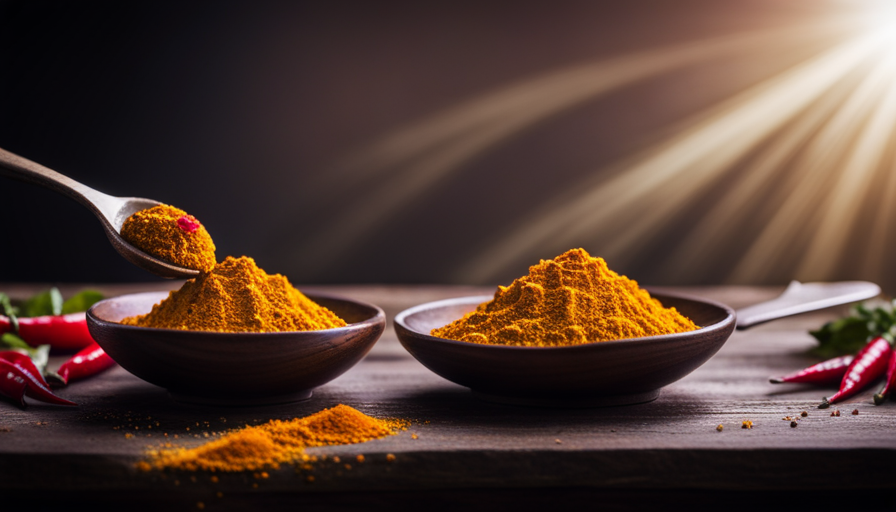I have always been a fan of turmeric tea, not only for its distinct flavor but also for its many health benefits. However, as I started paying more attention to my daily nutrition, I began to question the actual amount of turmeric in each cup of tea.
This led me on a research journey to understand the factors that determine the amount of turmeric in turmeric tea and how it affects our overall health.
In this article, we will explore the various aspects that influence the turmeric content in turmeric tea. From the quality of turmeric used to the brewing method and additional ingredients added, we will examine all essential elements that impact the potency of this popular beverage.
We will also discuss ways to measure the level of turmeric in your cup, along with important health considerations you should keep in mind when consuming this beverage regularly.
So let’s dive into understanding how much turmeric is present in your favorite cup of turmeric tea.
Key Takeaways
- The amount of turmeric in turmeric tea varies depending on the source, with ground turmeric powder typically containing 2-5% curcuminoids and fresh or dried turmeric root potentially containing higher concentrations.
- Quality turmeric for tea should have a bright yellow-orange color, strong aroma with earthy undertones, bitter and slightly pungent flavor, and fine texture without clumps or impurities. It should also be sourced from reputable sources with transparent sourcing information, ideally from organic farms and sun-dried for maximum potency.
- When brewing turmeric tea, a tea bag or 1-2 teaspoons of loose leaf tea should be steeped in hot water for 5-10 minutes at an optimal temperature of around 200°F.
- The recommended daily dosage of curcumin, the active compound in turmeric, varies depending on factors such as age, health condition, and purpose of consumption. Consuming up to 3 grams of curcumin daily is recommended for optimal health benefits, but it is important to consult with a doctor before adding turmeric into the diet regularly and to accurately measure the amount of turmeric in tea to prevent adverse side effects such as nausea and dizziness. Additional ingredients such as ginger, cinnamon, honey, lemon, and black pepper can enhance flavor and health benefits, but adding too many ingredients may dilute the concentration of turmeric in the beverage.
Understanding Turmeric Tea
If you’re curious about the amount of turmeric in your turmeric tea, you can easily make it yourself at home! Turmeric tea has been used for centuries as a natural remedy due to its potential health benefits. It’s believed that consuming turmeric tea can help reduce inflammation, improve brain function, and even lower the risk of chronic diseases such as cancer and heart disease.
There are many variations of turmeric tea recipes, but the most common recipe involves boiling water with fresh or ground turmeric root and adding additional ingredients such as ginger, honey, lemon juice, or cinnamon. Some people prefer to use milk instead of water to create a creamier texture. The possibilities are endless when it comes to making your own blend of turmeric tea!
Now let’s dive into how much actual turmeric content is in this popular beverage.
Turmeric Content in Turmeric Tea
You may be pleasantly surprised by the vibrant yellow hue of your homemade turmeric tea, a result of the generous amount of this fragrant spice that infuses every sip. But just how much turmeric is in each cup? A typical recipe calls for 1-2 teaspoons of turmeric powder per serving, which translates to approximately 2-4 grams. This small but mighty amount contains a variety of beneficial compounds such as curcuminoids and volatile oils that have been linked to potential health benefits like reducing inflammation and boosting immune function.
To put it into perspective, take a look at the table below which compares the amount of turmeric found in different forms:
| Turmeric Form | Amount Needed to Equal 1 tsp Powder |
|---|---|
| Fresh Turmeric Root | 1 inch piece (about 6g) |
| Dried Turmeric Root | 3-4 inches (about 5g) |
| Ground Turmeric Spice | 1 tsp (about 2g) |
While there are various ways to consume turmeric, incorporating it into your daily routine through drinking turmeric tea can be both enjoyable and beneficial. Experiment with different recipes and find what works best for you in terms of taste preferences and desired health outcomes. Moving on to the next section about ‘quality of turmeric used’, let’s explore how using high-quality sources can impact the potency and effectiveness of your turmeric tea.
Quality of Turmeric Used
When it comes to making turmeric tea, the quality of the turmeric used is crucial. High-quality turmeric not only ensures a rich and flavorful cup of tea, but also provides more health benefits due to its higher concentration of curcuminoids.
To choose quality turmeric, I always look for organic options that are sourced from reputable suppliers and have a vibrant yellow-orange color indicating freshness.
Importance of High-Quality Turmeric
Using top-notch turmeric in your turmeric tea can make all the difference, adding a touch of gold to your day. When it comes to turmeric sourcing, it’s important to choose high-quality turmeric that is rich in curcuminoids.
Curcuminoids are the active compounds found in turmeric that give it its anti-inflammatory and antioxidant properties. High-quality turmeric is typically sourced from organic farms where the soil is rich in nutrients and free from harmful chemicals.
The best quality turmeric is also hand-harvested and sun-dried to ensure maximum potency of curcuminoids. Using such quality ingredients can enhance the flavor and color of your tea while providing you with numerous health benefits.
Now let’s look at some tips on how to choose quality turmeric for your tea without compromising on its taste or efficacy.
How to Choose Quality Turmeric
Opting for high-quality turmeric can elevate the taste and nutritional value of your daily brew. There are a few key aspects to consider when selecting the best option. Choosing turmeric involves evaluating its quality, which can be determined by factors such as color, aroma, flavor, texture, and origin.
To ensure that you’re choosing the best turmeric for your tea, here are five things to keep in mind:
- Look for bright yellow-orange color
- Choose a strong aroma with earthy undertones
- Opt for a bitter and slightly pungent flavor
- Check for fine texture without clumps or impurities
- Select turmeric from reputable sources with transparent sourcing information
By considering these factors when choosing your turmeric root powder or fresh rhizome, you can guarantee that you’re getting a high-quality ingredient. This will enhance the overall taste and health benefits of your tea. As you move on to brewing methods, it’s important to note that the quality of your turmeric will play an essential role in how well it infuses into your liquid.
Brewing Method
To brew turmeric tea, simply steep a tea bag or 1-2 teaspoons of loose leaf tea in hot water for 5-10 minutes. The optimal temperature for brewing is around 200°F (or just under boiling), and it’s important to not over-brew the tea as it can become bitter.
Infusion time can be adjusted based on personal preference, but a general guideline is steeping for no longer than 10 minutes. When using tea bags, make sure to choose high-quality ones made with pure turmeric root rather than blends with added flavors or fillers.
Loose leaf tea allows for more control over the amount of turmeric used and can be combined with other spices like ginger or cinnamon for added flavor and health benefits. Once brewed, the tea can be enjoyed hot or cold with honey or lemon to taste.
Moving onto the topic of turmeric supplements, they can vary in potency and quality depending on the brand and ingredients used.
Turmeric Supplements
Now that we’ve discussed the brewing method for turmeric tea, let’s explore another way to consume turmeric – through supplements.
Turmeric supplements are available in various forms, such as pills, capsules, and powders. These supplements contain concentrated amounts of curcumin – the active ingredient in turmeric responsible for its medicinal properties.
When it comes to consuming turmeric through supplements, it’s essential to follow dosage recommendations carefully. The recommended dosage varies depending on factors such as age, health condition, and purpose of consumption. In general, a daily dose of 500-2000mg of curcumin is deemed safe for adults. However, it’s crucial to consult with a healthcare professional before starting any supplementation regimen.
Moving forward into our discussion about additional ingredients in turmeric tea, it’s important to note that certain ingredients can enhance the health benefits of this drink.
Additional Ingredients
Let’s spice up our turmeric beverage game with some delicious add-ins! While turmeric tea can be enjoyed on its own, incorporating additional ingredients can provide a variety of flavor combinations and added health benefits.
Some popular options include ginger, cinnamon, honey, lemon, and black pepper. Ginger not only adds a spicy kick to the tea but also has anti-inflammatory properties that complement those of turmeric. Cinnamon gives a warming flavor and has been shown to lower blood sugar levels. Honey adds sweetness without the use of refined sugars and provides antibacterial properties. Lemon adds a tangy taste while also being rich in vitamin C. Lastly, black pepper enhances the absorption of curcumin (the active compound in turmeric) by up to 2000%, making it an essential ingredient in any turmeric-based recipe. However, be mindful that adding too many ingredients may dilute the concentration of turmeric in your beverage.
Moving onto measuring turmeric content…
Measuring Turmeric Content
Measuring the amount of turmeric in your beverage can be a challenge, but fear not, there’s a simple trick to ensure you’re getting enough of this golden spice for its health benefits – just a pinch goes a long way!
However, it’s important to consider measuring accuracy when determining the amount of turmeric to add to your tea. Firstly, it’s worth noting that the turmeric content in different sources can vary. The most common source is ground turmeric powder, which typically contains 2-5% curcuminoids (the active ingredient). Fresh or dried turmeric root may have slightly higher concentrations, while commercially available supplements may contain much higher levels.
To accurately measure the amount of turmeric in your tea, start with a small amount and increase gradually until you find the desired taste and color. It’s also important to mix well as turmeric tends to settle at the bottom.
When considering health benefits associated with consuming turmeric tea, one should keep in mind any potential interactions with existing medical conditions or medications.
Health Considerations
As I’m exploring the world of turmeric tea, I’ve come across some commonly asked questions regarding its health considerations. To help answer these inquiries, I’ve compiled expert answers to provide informative and objective insight.
Whether you’re curious about potential benefits or concerns surrounding turmeric tea consumption, this discussion aims to shed light on any uncertainties.
Commonly Asked Questions about Turmeric Tea
To fully understand the benefits of turmeric tea, you may be wondering about the amount of turmeric that’s typically used in a single cup. The answer varies depending on personal preference, but on average, one teaspoon of ground turmeric per cup is recommended. This should provide enough flavor and health benefits without overpowering the taste or causing any negative side effects.
It’s important to note that while turmeric does have many health benefits, consuming too much can lead to adverse side effects such as nausea and dizziness. It’s always best to start with a smaller amount and gradually increase if desired. Additionally, it’s recommended to speak with a healthcare professional before incorporating large amounts of turmeric into your diet if you’re taking any medications or have pre-existing health conditions.
With proper moderation and guidance from a medical professional, the consumption of turmeric tea can provide numerous benefits for overall health and wellness.
Moving onto expert answers to your queries, let’s explore some common questions people have about this popular beverage.
Expert Answers to Your Queries
Moving on to our current subtopic, as an expert in the field of nutrition, I’m often asked about the benefits and dosage of turmeric tea. Turmeric has been used for centuries in Ayurvedic medicine for its anti-inflammatory and antioxidant properties. It’s gained popularity in recent years because of its potential health benefits, such as reducing inflammation, improving brain function, and boosting the immune system.
When it comes to turmeric tea, the amount of turmeric varies depending on the recipe or brand. However, a typical serving size may contain around 1-2 grams of turmeric powder, which is equivalent to ½ – 1 teaspoon. This amount can provide some health benefits, but if you’re looking for therapeutic effects, a higher dosage may be required.
In general, it’s recommended to consume up to 3 grams of curcumin (the active compound in turmeric) daily for optimal health benefits. It’s important to note that excessive consumption of turmeric may have side effects, so make sure to consult with your doctor before adding it into your diet regularly.
Frequently Asked Questions
What is the history of turmeric tea and how has it been used traditionally?
As a lover of turmeric tea, I’ve explored its traditional use and health benefits. This ancient Indian beverage has been used for centuries to aid digestion, reduce inflammation, and boost immunity. Its popularity continues to grow today as more people discover its incredible healing properties.
Can turmeric tea be consumed by pregnant women or individuals with specific health conditions?
As a healthcare professional, I advise pregnant women and individuals with health conditions to consult their doctor before consuming turmeric tea. Turmeric may interact with certain medications and could potentially cause complications. It’s important to prioritize safety and seek medical advice.
Are there any potential side effects or interactions with other medications or supplements when consuming turmeric tea?
Oh joy, another thing to worry about! Turmeric tea has a recommended dosage of 1-2 grams per day, but be cautious with possible contraindications such as blood thinners and acid reflux medication.
How can the taste of turmeric tea be enhanced or adjusted to personal preference?
To enhance or adjust the taste of turmeric tea to personal preference, add honey, lemon juice, ginger, or cinnamon. Flavor variations can also be achieved by using different types of milk or alternative sweeteners.
Is there a recommended frequency or serving size for consuming turmeric tea to reap its health benefits?
To reap the health benefits of turmeric tea, it is recommended to consume 1-2 servings per day. Each serving should contain around 1 teaspoon of turmeric powder and be brewed in hot water for 5-10 minutes.
Conclusion
In conclusion, the amount of turmeric in turmeric tea can vary depending on several factors such as the quality of turmeric used and the brewing method. It’s important to note that not all turmeric teas are created equal, and it’s essential to choose a high-quality brand with a significant amount of curcumin, the active ingredient in turmeric.
While measuring the exact amount of turmeric in homemade tea may be challenging, one can always opt for supplements or pre-packaged teas with standardized amounts. However, it’s crucial to consult a healthcare professional before incorporating any new supplement into your diet.
As I wrap up this informative piece, remember that the proof of the pudding is in the eating. So, go ahead and try out different brands and variations until you find one that suits your taste buds while providing maximum health benefits.










